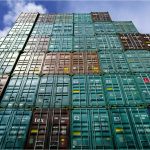Massive Chinese Lockdowns Present More Supply Chain Disruption
China’s insane Covid Zero policies strike again. The country has shut down an entire province due to a rise of Covid-19 cases. This has millions of people locked in their homes, major manufacturing hubs shut down, and adds yet another large disruption to the global supply chain. But at least it follows a strategy proven to be effective in fighting coronavirus. Oh wait, lockdowns have been shown over and over again not to work. And China has been so strict with Covid regulation that a single positive test is enough to close a major port terminal. But maybe if China just follows failed tactics and policies on a larger scale…
China placed the 17.5 million residents of Shenzhen into lockdown for at least a week and forbade people from leaving Jilin, the first time the government has sealed off an entire province since the area surrounding Wuhan was isolated in early 2020.

Joe McDonald of the Associated Press (AP) reports:
Chinese authorities on Tuesday tightened anti-virus controls at ports, raising the risk of trade disruptions after some auto and electronics factories shut down as the government fights coronavirus outbreaks.
Stock prices in China and Hong Kong sank for a second day following the shutdown on Monday of Shenzhen, a tech and finance hub adjacent to Hong Kong in the south, and Changchun, an auto center in the northeast. Bus service to Shanghai, China’s business capital and biggest city, was suspended.
…
“We can think of no risk to the global economy, excluding nuclear warfare, that is greater than the risk of a COVID outbreak in China that shutters industrial production,” said Carl B. Weinberg of High-Frequency Economics in a report. “Uncountable manufacturing supply chains pass through China.”
Economists say for now, smartphone makers and other industries can use factories and suppliers in other parts of China. But a bigger threat looms if business is disrupted at ports in Shenzhen, Shanghai or nearby Ningbo.
Are Ports Shutting Down?
How likely is it that the ports will be impacted? Well…
American Shipper published an article yesterday by Lori Ann LaRocco entitled, “Logistics companies warn clients lockdown in Shenzhen will impact port activity.”
That makes it sound not only likely but an absolute that ports will be impacted. It’s hard to imagine there will be no impact, but how much disruption will happen – and even is happening – is unclear.
Initially, LaRocco reported information from Seko Logistics that no cargo would load in Yantian because of the lockdowns. But Seko corrected itself later that cargo was being loaded at operational terminals in Yantian, so the article itself was updated:
With China locking down the port city of Shenzhen on Sunday in hopes of reducing a COVID-19 spread, Seko Logistics warned clients that the measure will impact the delivery of products from that region.
Other companies, including Worldwide Logistics Group and Orient Star Group, also issued advisories about a potential disruption.
Seko’s COVID-19 advisory note on Sunday explained that because of the weeklong lockdown in Shenzhen, “no cargo will be able to load in Yantian … and vessels most likely will omit the port.”
But on Monday afternoon, Seko issued a corrected advisory. “We have been advised that Yantian port terminals are operating and loading cargo,” the amendment stated.
Trucking restrictions for vehicles traveling in and out of Shenzhen remain in effect and could slow the supply chain, since no cargo from outside the restricted area can enter.
Risk of Repeat of Yantian Port Closure
LaRocco went on to provide a reminder of what bad news shutting down the Port of Yantian is for shippers, who have seen so many supply chain disruptions over the last two years they amazingly probably need the reminder:
China’s “zero-COVID” strategy was previously used in Yantian in 2021, when it was closed for a month between May and June. The move created havoc on the supply chain, and the clog took months to dissolve.
Greg Miller provided perspective on that shutdown in another American Shipper article:
When an outbreak hit the Yantian terminal in Shenzhen last June, twice as many vessels were delayed as in the Ever Given accident in the Suez Canal.
Even if the terminals at the Port of Yantian are not officially shut down, it’s hard to imagine the lockdown on Shenzhen not affecting the movement of goods. As LaRocco writes, “The issue is that trade and manufacturing take people. If workers cannot leave their houses, nothing can get made or transported.”
List of Current Lockdown Impacts
Seko, in its advisory, gave a bulleted update on the situation in Shenzhen, which LaRocco included an image of at the end of her article. Here are some highlights to know about China’s latest Covid Zero actions.
- Shenzhen is locked down from March 14-20th.
- Restrictions are now in effect across all of Shenzhen. For the next week, no one will be allowed to leave their apartment complex except to do three rounds of Nucleic Acid Testing.
- For the following week, all public transportation in Shenzhen stops operating
- All businesses in Shenzhen will be closed from March 14th-20th unless considered essential services.
- Yantian Free Trade Zone will be closed from March 14th-20th.
- All vessels at Yantian Port already loaded and departing this week will depart as planned.
- No cargo will load in Yantian from next week and vessels most likely will omit the port.
- There has not been an advisory of official restrictions to Shenzhen Airport; however, staff members are unable to leave their homes to work at the airport
- Trucks from outside Shenzhen are unable to enter the city.
- Cross border shipments from Shenzhen to Hong Kong will not move unless they carry essential goods to Hong Kong.
It’s impossible to know just how much disruption we’re going to see. But it is good news that initially movement of goods has happened at the ports, but it feels like everyone is just waiting for the other shoe to drop.
Greg Miller’s American Shipper article also provides updates on what’s happening with shipping during China’s “massive lockdowns”:
Liner giant Maersk reported Monday that all ports in China, including those in Shenzhen, were operating normally and “remain business as usual.” Warehouses in Shenzhen are closed through Sunday. Warehouses in Shanghai and Qingdao remain open, although truckers require negative COVID tests to pick up cargo.
Some Good News?
What’s interesting is that there are some projecting it would be good news if the ports remain open while manufacturers close for a little bit. Of course, if ports close, that’s bad news all around. Miller continues in his article:
Griffiths told American Shipper, “If no ports shut down but volumes coming out of factories are reduced [by lockdowns] that actually would be pretty good for ports.” It would allow more backlogs at Chinese export terminals to get loaded on ships, and help to normalize supply chain flows without forcing carriers to “blank” (cancel) sailings.
If Chinese ports do close, causing ships to drop calls or blank entire sailings, it would be short-term positive for U.S. ports — but they’d pay the piper later.
Demand Finally Falling
Of note, U.S. demand for Chinese goods is not as strong as it was a year ago when Yantian Port was closed. This could help the impact of the lockdowns in China not to be as bad for shippers and the supply chain as the previous disruption at the Yantian Port. Miller reports:
It was historically high in 2021 and appears to have at least temporarily slackened in 2022, beyond the normal Lunar New Year lull.
“We haven’t seen large volumes being booked for February or March, although April’s looking fairly tight. We’re seeing some improvement from where we were immediately post-Lunar New Year, but it’s still fairly tepid,” said Griffiths.
I’m still of a mind we’re going to see serious reduction in demand because of the running out of government stimuli and rampant inflation. For a long time, I’ve been predicting those two factors (along with more and more reductions to Covid restrictions keeping people from going out and traveling) to decrease demand. I’ve even been warning with this that there’s a risk of a serious crash. I expected to see these factors come into play and reduce demand well before now. In actuality, we’re just starting to really see it happen, though inflation has been a serious problem since our elected officials started pumping trillions of dollars into the demand side of the economy while hitting the supply side with heavy regulatory restrictions – most around Covid and climate change politics.
Key takeaway: strap in. Things could get real ugly.




